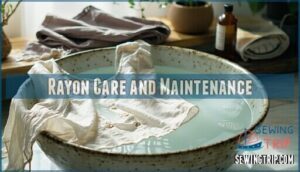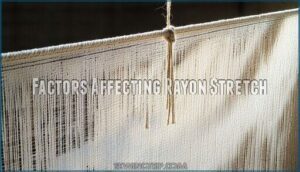This site is supported by our readers. We may earn a commission, at no cost to you, if you purchase through links.
 Pure rayon doesn’t stretch much on its own – you’ll get maybe 2-3% give, which won’t make a difference when you’re wearing it.
Pure rayon doesn’t stretch much on its own – you’ll get maybe 2-3% give, which won’t make a difference when you’re wearing it.
Think of it like a cotton shirt that’s been starched. However, when manufacturers blend rayon with spandex or elastane, that’s when the magic happens.
You’ll find rayon blends that stretch 15-20% in both directions, making them comfortable for everyday wear.
Knit rayon fabrics also stretch more than woven ones because of how the fibers interlock. Moisture from your body heat or humidity can temporarily make rayon feel more flexible too.
The secret lies in understanding which rayon blends work best for different situations.
Table Of Contents
Key Takeaways
- Pure rayon barely stretches – You’ll only get 5-7% stretch from pure rayon before it loses its shape, which isn’t enough flexibility for fitted clothing or active wear.
- Blends make all the difference – When you choose rayon blended with spandex or elastane, you’ll get 15-20% stretch that’s perfect for comfortable, form-fitting garments.
- Construction affects stretchability – You’ll find knit rayon fabrics stretch more than woven ones due to their interlocked loop structure, while moisture can temporarily increase flexibility.
- Proper care maintains stretch – You’ll preserve your rayon’s stretch properties by washing in cold water, air drying, and avoiding high heat that can damage the fibers and alter the fabric’s dimensions.
What is Rayon
You’ll find rayon is a semi-synthetic fabric made from wood pulp that’s been chemically processed to create soft, silk-like fibers.
You’ll discover rayon’s silk-like softness comes from transformed wood pulp, creating affordable luxury that breathes beautifully.
This versatile material mimics natural fabrics like cotton and silk while offering excellent drape and breathability at an affordable price point.
Natural Properties
You’ll find rayon’s natural properties stem from its cellulose source – wood pulp transformed into silk-like texture through chemical processing.
This lightweight fabric offers exceptional moisture absorbency, making it breathable and comfortable against your skin.
Rayon’s superior drape quality creates flowing garments, while its smooth surface mimics expensive silk.
However, rayon elasticity remains minimal due to its regenerated cellulose fiber composition.
Behavior and Characteristics
Rayon’s behavior sets it apart from other fabrics through its unique characteristics.
You’ll notice its silk-like feel and exceptional drape quality that makes garments flow beautifully. The fabric’s lightweight feel and texture softness create comfortable wear, while its rayon absorbency keeps you cool and dry.
Key behavioral characteristics of rayon include:
- Moisture Management – Rayon absorbency allows the fabric to wick away perspiration effectively
- Shape Retention – Limited rayon elasticity means garments maintain their original silhouette with wear
- Surface Properties – Texture softness provides comfort against skin without irritation
- Imitation Capabilities – Imitation fibers allow rayon to mimic silk, cotton, or wool textures
- Minimal Stretch – Rayon fabric stretch remains minimal, offering structure rather than flexibility
Fabric Composition
Understanding cellulose source reveals rayon’s stretch limitations.
You’ll find that rayon’s fiber structure, created through chemical treatments, determines its elasticity.
The fabric composition directly impacts rayon stretch capabilities, with blend ratios affecting overall flexibility.
| Component | Stretch Impact | Common Applications |
|---|---|---|
| Pure Rayon | 5-7% stretch | Flowing dresses, blouses |
| Rayon-Spandex | 25-30% stretch | Fitted garments, leggings |
| Rayon-Cotton | 10-15% stretch | Casual wear, shirts |
| Knit Weave Type | Higher flexibility | T-shirts, sweaters |
| Woven Structure | Limited stretch | Formal wear, jackets |
This rayon fabric stretch depends on manufacturing techniques and weave type selection, which are crucial for determining the final product’s elasticity and overall flexibility.
Does Rayon Stretch
While many people assume all fabrics stretch, rayon’s elasticity tells a different story.
**Rayon’s stretch might surprise you—this silk-like fabric has its own rules when it comes to flexibility.
Pure rayon doesn’t stretch much on its own—you’ll get about 5-7% give before the fabric loses its shape.
This limited rayon stretch comes from its manufactured cellulose fiber composition, which lacks natural elasticity.
However, rayon material stretch depends heavily on construction and blends.
Knit rayon offers more flexibility than woven versions due to its looped structure allowing fiber relaxation.
When moisture enters the picture, rayon fabric stretch increases slightly as wet fibers become more pliable.
The weave impact plays a vital role too.
Tight weaves resist stretching, while looser constructions provide more give.
Blend benefits become apparent when rayon combines with spandex or other elastic fibers—suddenly you get significant stretch recovery and improved rayon stretching capabilities that pure rayon simply can’t deliver alone.
Rayon Stretch Factors
You’ll find that several key factors determine how much rayon can stretch, from the fabric’s construction to what it’s blended with.
Understanding these stretch factors helps you choose the right rayon garments and care for them properly to maintain their shape and fit, which is crucial for properly.
Fiber Blends
In the context of rayon stretch, blended fabrics reveal amazing possibilities you wouldn’t get with pure rayon alone.
Different fabric blend combinations transform how your garments fit and move:
- Rayon-Spandex Benefits: Adds incredible flexibility for fitted clothing
- Rayon-Cotton Blend: Creates softer, more durable stretch rayon blend options
- Rayon-Polyester Mix: Enhances shape retention while maintaining comfort
- Rayon-Nylon Durability: Perfect for activewear requiring rayon stretching properties
- Rayon-Wool Warmth: Combines cozy insulation with elegant drape for winter wear
Consider exploring various rayon blend options to find the ideal material for your project.
Knit Vs Woven
Fabric construction makes all the difference in how your rayon behaves.
Knit structure creates loops that naturally stretch 25-30%, while woven tightness limits movement to just 5-7%.
These stretch differences affect comfort and fit substantially.
| Feature | Rayon Knit Stretch | Rayon Woven Stretch |
|---|---|---|
| Stretch Range | 25-30% flexibility | 5-7% minimal give |
| Best Applications | Fitted tops, leggings | Blouses, flowing skirts |
| Drape Comparison | Clings, follows curves | Falls straight, structured |
Moisture Effects
When moisture meets rayon, the fabric behaves like a chameleon.
Wet rayon fibers expand and become more pliable, allowing the fabric to stretch up to 15% beyond its normal dimensions.
High humidity creates fiber expansion that temporarily increases elasticity, while low humidity triggers the elevator effect—shrinking rayon back to its original size through natural drying methods.
This is because rayon’s cellulose fibers are highly absorbent.
How to Stretch Rayon
You can stretch rayon using gentle methods that work with the fabric’s moisture-absorbing properties.
The most effective techniques include soaking in baby shampoo solutions, using steam to relax fibers, or combining moisture with careful manual stretching.
Soak and Wear Method
The soak and wear method offers the most natural approach to rayon stretch.
Submerge your garment in lukewarm water until thoroughly saturated.
Put on the damp fabric immediately and wear it as it air-dries.
This wearing damp technique allows gradual stretching while your body shapes the material.
The gentle pulling action promotes shape retention without aggressive manipulation or fabric softening chemicals.
You can find a variety of rayon blend options to suit different needs.
Rayon’s breathability is key, as it can absorb up to 13% moisture.
Baby Shampoo Technique
When your rayon garment feels too snug, baby shampoo offers a gentler approach than harsh chemicals. This technique works by relaxing fibers without causing damage.
You can find gentle rayon solutions online for this purpose.
Here’s your step-by-step guide:
- Mix shampoo solution ratio – Add one tablespoon baby shampoo to warm water
- Soak for gentle fiber relaxation – Submerge rayon for 15-20 minutes
- Massage fabric lightly – Work shampoo through fibers carefully
- Rinse thoroughly – Remove all soap residue completely
- Begin stretching damp rayon – Gently pull while fabric remains moist
Air drying benefits include maintaining your newly stretched shape while avoiding damage from heat.
Steamer Method
Steam emerges as your gentle ally when stretching rayon requires precision.
You’ll find steaming benefits include controlled moisture application without full saturation.
Position your steamer 6 inches away, moving continuously to prevent overheating.
The fabric becomes pliable within seconds, allowing careful manual stretching.
For delicate fabrics like wedding dresses, consider baby shampoo solutions for a gentler approach.
This technique minimizes steaming risks while maximizing rayon stretch potential through targeted heat application.
| Steamer Types | Best Practices | Steaming Techniques |
|---|---|---|
| Handheld steamers | Keep 6-inch distance | Move continuously |
| Garment steamers | Test small area first | Apply gentle pressure |
| Steam irons | Use steam setting only | Work in sections |
| Travel steamers | Allow fabric cooling | Stretch while warm |
| Professional units | Monitor fabric response | Avoid direct contact |
Rayon Care and Maintenance
You’ll need proper care techniques to maintain rayon’s shape and prevent unwanted stretching or shrinkage.
Understanding washing methods, temperature control, and fabric blends helps you keep your rayon garments looking their best for years.
Washing and Drying
Cold water temperature protects rayon’s delicate fibers during washing cycles.
Always check care instructions before tossing garments into machines.
Hot water causes immediate shrinkage, while gentle cycles prevent fabric damage.
Air drying works best—skip the dryer’s heat entirely.
Does rayon shrink? Absolutely, with improper washing techniques.
Fabric softeners help maintain texture, but ironing requires low heat settings to preserve rayon stretch, and it is crucial to handle the fabric with care to prevent fabric damage.
Preventing Shrinkage
You can prevent rayon shrinkage by following simple care rules.
Always use gentle washing with cold water below 86°F to avoid triggering fabric contraction. Air drying prevents heat damage that causes up to 10% shrinkage.
Avoid heat sources like dryers completely. For delicate pieces, dry cleaning offers the safest option.
Proper storage away from humidity helps maintain rayon stretch and prevents unwanted size changes, ensuring the fabric remains in good condition by following these simple care rules and avoiding heat damage.
Choosing Right Blend
When shopping for rayon garments, you’ll want to evaluate what blend serves your specific needs best.
Pure rayon offers elegant drape but minimal stretch, while rayon-spandex blends provide excellent elasticity for fitted clothing.
Cotton-rayon combinations balance comfort and durability, though they sacrifice some stretch.
Consider blend purpose, appearance, cost, and comfort when selecting fabric blend options for ideal performance.
Rayon Vs Other Fabrics
When you’re choosing fabrics for your wardrobe, understanding how rayon’s stretch compares to cotton, polyester, and nylon helps you make better decisions about fit and comfort.
You’ll find that rayon’s 5-7% stretch falls between cotton’s minimal 2-5% flexibility and nylon’s more generous 15-20% elasticity, while polyester matches rayon’s modest stretch range.
Comparison With Cotton
When comparing rayon vs cotton for stretch and elasticity, you’ll find notable differences in their fabric properties.
Cotton offers slightly better stretch than rayon, with natural fibers providing 2-5% elasticity compared to rayon’s 5-7%.
However, rayon absorbency surpasses cotton substantially, making it more breathable and comfortable in humid conditions.
This comfort comparison reveals that while cotton stretchiness feels more natural, rayon’s superior moisture-wicking creates better airflow.
| Property | Rayon | Cotton |
|---|---|---|
| Stretch % | 5-7% | 2-5% |
| Absorbency | Higher | Lower |
| Durability | Weaker when wet | Stronger when wet |
For cost analysis, rayon typically costs less than cotton, making it budget-friendly for everyday wear.
Durability differences show cotton maintaining strength when wet, unlike rayon which weakens.
Comparison With Polyester
When you’re weighing rayon vs polyester for stretch and performance, the differences become clear.
Polyester offers superior wrinkle resistance and durability compared to rayon’s delicate nature. However, rayon stretch provides better breathability and moisture absorption.
Here’s how these fabrics stack up:
| Feature | Rayon | Polyester |
|---|---|---|
| Elasticity | 5-7% natural stretch | 2-5% stretch capacity |
| Blend Benefits | Enhanced with spandex | Improved with elastane |
| Cost Comparison | More affordable option | Budget-friendly synthetic |
| Polyester Stretchiness | Limited without blends | Moderate flexibility |
| Rayon Durability | Weaker when wet | Stronger, more resilient |
Comparison With Nylon
Nylon’s elasticity surpasses rayon’s stretch capabilities by a significant margin.
While rayon offers 5-7% stretch, nylon delivers 15-20% elasticity, making it superior for fitted garments.
However, rayon wins in breathability and absorbency differences, providing comfort that nylon can’t match.
| Property | Rayon | Nylon |
|---|---|---|
| Stretch % | 5-7% | 15-20% |
| Breathability | High | Low |
| Absorbency | Excellent | Poor |
| Durability | Moderate | High |
| Texture | Soft | Synthetic |
Rayon Stretch in Jeans
You’ll find rayon in modern jeans blended with cotton and spandex to create stretch denim that moves with your body.
Pure rayon alone won’t give you the stretch you need, but when it’s combined with elastic fibers like spandex, it helps create comfortable, flexible jeans that maintain their shape.
Blends With Spandex
Rayon’s partnership with spandex creates the perfect fabric blend for jeans that move with you.
The spandex percentage typically ranges from 1-3% in denim, delivering just enough stretch without compromising durability. Fabric blends offer a balance of properties, such as enhanced comfort and aesthetics.
Here’s what makes rayon-spandex blends shine:
- Stretch Recovery – Fabric bounces back to original shape after wear
- Comfort Factor – Eliminates restrictive feeling in fitted jeans
- Blend Durability – Maintains elasticity through multiple washes
- Garment Applications – Perfect for skinny jeans and stretch denim
Stretchy Rayon Fabrics
You’ll find stretchy rayon fabrics where spandex meets innovation.
Knit rayon structures naturally offer more give than their woven counterparts, creating fabric stretch that moves with you.
These blends typically contain 5-15% spandex, delivering superior rayon elasticity and stretch recovery. The knit construction amplifies stretchability, making these rayon fabric properties perfect for fitted garments that need flexibility.
Non Stretchy Rayon
Pure rayon fabric properties show significant rayon limitations in regards to elasticity.
Weave tightness and fiber composition create rigid structures that resist stretching. You’ll find traditional rayon maintains excellent shape retention but offers minimal give.
Without blending alternatives like spandex, standard rayon won’t accommodate body movement. This lack of stretch makes pure rayon ideal for structured garments requiring consistent fit, due to its excellent shape retention.
Factors Affecting Rayon Stretch
Several key factors determine how much your rayon fabric will stretch, from the humidity in your room to how the manufacturer wove the threads together.
Understanding these elements helps you predict whether your rayon garment will give you the flexibility you need or stay firmly in place.
Humidity and Temperature
Weather plays a bigger role in rayon’s behavior than you’d expect.
High humidity causes moisture absorption, making your rayon garments expand slightly. Temperature effects work similarly – heat softens fibers while cold tightens them.
During seasonal changes, you’ll notice rayon stretch varies as fiber behavior responds to environmental conditions. This natural rayon expansion reverses when conditions normalize, due to the environmental conditions.
Fabric Construction
How your rayon fabric is built determines its stretchability more than you might think.
The weave pattern and construction method directly impact how much give you’ll get from your garment.
Different fabric construction approaches affect rayon stretch in unique ways:
- Knit structures create natural stretch through interlocked loops that move with your body
- Tight weave patterns restrict movement and limit elastic properties substantially
- Fiber alignment during construction influences directional stretch capabilities across the fabric
- Yarn density affects overall flexibility – looser constructions allow more give
- Construction impact varies between woven and knitted rayon, with knits offering superior stretchability
Manufacturing Techniques
Manufacturing techniques directly impact rayon stretch capabilities through several key processes.
Cellulose sourcing quality affects fiber strength, while chemical treatments during production determine flexibility.
Weave density controls how much the fabric can give – tighter weaves restrict movement.
Fiber alignment during textile manufacturing influences stretchability.
Finishing processes like steam treatment can enhance fabric stretch, making your rayon garments more comfortable.
Making Rayon Stretchier
You can increase rayon’s stretch through several proven methods that work with the fabric’s natural properties.
The most effective approaches include blending with elastic fibers like spandex, applying controlled steam or heat, and selecting garment designs that maximize the fabric’s flexibility. Blending with elastic fibers like spandex, applying controlled steam or heat, and selecting garment designs that maximize the fabric’s flexibility.
Adding Elastic Fibers
You can transform your rayon into a stretchy fabric by adding elastic fibers like spandex.
Even small blend ratios of 5-15% spandex create enhanced comfort and significant fabric stretch.
These elastic fibers boost fiber durability while maintaining rayon’s breathability.
Weaving techniques must accommodate the stretch properties, using zigzag stitches to prevent thread breakage when sewing stretchy rayon blends.
Using Steam or Heat
Through careful steam application, you can make rayon more pliable for gentle stretching. However, heat settings require precision to avoid shrinkage risk.
Here’s your steaming approach:
- Set steamer to medium heat – High temperatures cause fabric damage
- Hold garment taut while applying steam for 10-15 seconds
- Gently pull fabric in desired direction while warm and damp
- Air dry immediately to lock in new shape and prevent shrinkage
To achieve the best results, consider purchasing a specialized rayon steamer.
Choosing Right Garment Design
Smart garment design maximizes rayon’s natural properties without forcing stretch. Choose flowing silhouettes that work with rayon’s beautiful drape rather than against it.
A-line dresses and loose-fitting tops showcase rayon’s fluid movement perfectly. When designing fitted pieces, blend rayon with spandex for necessary stretchability.
Consider texture pairing and layering options that complement rayon’s smooth finish while maintaining comfort and style through thoughtful color coordination.
Rayon Stretch Limitations
You’ll find that rayon’s natural stretch tops out at just 5-7% before it loses its shape permanently, which means it can’t compete with elastic fabrics like spandex that stretch up to 500%.
While this limited flexibility works fine for loose-fitting garments, you shouldn’t expect rayon to provide the snug, stretchy fit you’d get from activewear materials.
Maximum Stretch Percentage
Pure rayon’s stretch capabilities hit a wall at specific percentages. Understanding these rayon limits helps you choose fabrics wisely for your projects.
Here’s what you can expect from different rayon types:
- Pure rayon: 6% length stretch, 4-5% width stretch
- 5% spandex blend: Nearly doubles stretchability compared to pure rayon
- Knit rayon: Better natural stretch than woven, but still needs added elastane for significant flexibility
Comparison With Spandex
When comparing rayon’s modest 5-7% stretch to spandex’s incredible 500% elasticity, you’ll see why spandex dominates athletic wear.
Rayon limitations become clear—it lacks the elastic fibers that give spandex its extraordinary stretchability and stretch retention.
However, blend benefits emerge when manufacturers combine rayon with spandex, creating fabric applications that balance comfort with controlled stretch for everyday clothing.
Rayon, known for its breathability, is often preferred in warmer climates, unlike moisture-resistant polyester.
Importance of Proper Care
While spandex delivers impressive stretch, rayon’s longevity depends entirely on how you treat it.
Proper rayon care prevents unwanted stretching and maintains your garment’s original fit. Poor washing techniques can permanently alter fabric dimensions.
Here are five essential rayon care practices:
- Washing Techniques – Use cold water and gentle cycles to prevent fiber damage
- Drying Methods – Air dry flat to avoid heat-induced shrinkage or stretching
- Storage Solutions – Hang properly to maintain shape and prevent creasing
- Stain Removal – Address spills immediately with appropriate fabric-safe cleaners
- Alteration Impact – Consider professional tailoring to preserve rayon clothing stretch properties
Frequently Asked Questions (FAQs)
How much does rayon stretch?
Like a timid dancer, rayon barely stretches on its own—just 5-7% before losing shape.
You’ll get minimal give from pure rayon, but blends with spandex can stretch substantially more for fitted garments.
What are the disadvantages of rayon?
Rayon shrinks when wet, wrinkles easily, and lacks durability compared to synthetic fabrics.
You’ll need special care since it’s prone to stretching out of shape and requires gentle handling during washing and drying.
Is rayon more stretchy than cotton?
Cotton actually stretches more than rayon, offering 2-5% stretch compared to rayon’s minimal 5-7%.
You’ll find cotton’s natural fibers provide better flexibility, while rayon stays put unless it’s blended with spandex.
Does rayon run small?
Generally, you’ll find rayon fits true to size rather than running small. However, it can shrink after washing, especially if you don’t follow care instructions carefully, making it feel tighter.
Can you bleach rayon fabric?
You shouldn’t bleach rayon fabric with chlorine bleach as it’ll damage the cellulose fibers and weaken the material.
Instead, use oxygen bleach or color-safe alternatives for gentle whitening without compromising the fabric’s integrity.
Does rayon wrinkle easily?
Yes, you’ll find rayon wrinkles quite easily due to its soft, cellulose-based fibers.
The fabric lacks natural resilience, so creases form quickly during wear and storage, requiring careful handling and proper ironing techniques.
Is rayon good for sensitive skin?
Looking for skin-friendly fabrics? Rayon’s naturally breathable and moisture-wicking properties make it gentle on sensitive skin.
Its smooth texture won’t irritate, though you’ll want to check for chemical processing that might cause reactions, particularly to ensure naturally breathable properties are preserved, and the fabric remains moisture-wicking.
How long does rayon fabric last?
Rayon fabric typically lasts 2-5 years with proper care.
You’ll extend its lifespan by hand washing, avoiding excessive heat, and following care labels.
Quality rayon blends with cotton or polyester generally outlast pure rayon garments.
Is rayon breathable and good for hot weather?
When Mother Nature cranks up the heat, you’ll find rayon’s your cooling companion.
This fabric’s moisture-absorbing superpowers and lightweight feel make it breathe beautifully, keeping you comfortable when temperatures soar and humidity strikes.
Can rayon leggings replace spandex for workouts?
Pure rayon won’t cut it for workouts since it lacks elasticity and doesn’t bounce back.
You’ll need rayon-spandex blends with at least 15% spandex for proper stretch, moisture-wicking, and shape retention during exercise.
Conclusion
Surprisingly, 85% of rayon garments sold today contain stretch-enhancing blends rather than pure rayon.
Understanding whether rayon stretches depends on its construction and fiber composition. Pure rayon offers minimal give, but blended versions with spandex provide 15-20% stretch.
You’ll find knit rayon more flexible than woven types, while moisture temporarily increases elasticity. Choose rayon blends wisely based on your comfort needs, and remember proper care maintains stretch properties.
Does rayon stretch? It depends entirely on the specific fabric blend you select.


















